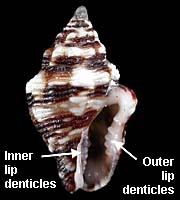|
< Previous family introduction |
|
|||||
|
|
Family Columbellidae Dove shells
|
|||||
|
This is a family of about four hundred species with small to medium sized shells, distributed world-wide, common in the tropics but also in temperate Australia. They occur from the intertidal down to at least 1000 m deep. The family is close to the Buccinidae anatomically, being differentiated by radular features and differences in the alimentary and reproductive systems. Columbellids are active, crawling snails that live in a variety of habitats. The majority of species live on hard substrates, crawling on the underside of stones or on algae, but some species crawl in sand in seagrass beds. They are unusual among advanced gastropods in that a few species include both plant and animal material in their diets. Species that live on seagrass are grazers, consuming the diatoms, sponges and other animal life forms on the seagrass fronds, while also consuming the plant material. Carnivorous species are known to include other molluscs, polychaete worms, crustaceans and ascidians in their diet. The family is marked by great variability, both between and within species. Shell form varies from biconic and ovate shapes typical of the Buccinidae to elongate shapes more typical of the Mitridae and Turridae. Within some groups, particularly the southern Mitrella species, there is extreme variation of colour pattern from uniformly pale to uniformly dark with a wide array of stripes and spots in between. In the minute species Anachis atkinsoni shell form and pattern is so variable that it is difficult to believe that only one species is present. The classification within the family suffers from a lack of overall synthesis. Radwin (1977a, 1977b, 1978) has studied the Atlantic species. The larger Indo-West Pacific species are relatively well known, but the southern Australian fauna, particularly the deep-water species, are known only from empty shells and have been assigned to genera without adequate justification. DeMaintenon (1999) has presented a phylogenetic analysis based on 23 species but did not include most of the genera of interest in southern Australia. The NSW fauna contains representatives of tropical Indo-West Pacific groups, a southern Australian endemic group, deep water species, and one introduced species. Common tropical species of Euplica and Mitrella occur in northern NSW, sometimes reaching further south to be uncommon at Sydney. The endemic southern Australian group consists of nine species, eight of which occur in NSW. Three of the species - Mitrella australis, M. tayloriana and M. intexta - are almost restricted to NSW, with M. tayloriana being the most common columbellid in the state, and a prominent member of the intertidal algal fauna. The species Mitrella bicincta has been introduced from east Asia, and is now common in central NSW. In addition to the intertidal and shallow water species, there are continental shelf and slope species that occur down to at least 1000 m deep. Family References On a world-wide basis there has been no revision of the family, and no consolidated reference since Reeve's Conchologia Iconica in the mid-19th century. Wilson (1994) gives a compilation of the Australian species, but this is severely limited by the inadequate knowledge of the family. There has been no revision or comprehensive reference to the NSW species. All the named species from NSW are detailed here. There seems to be about 10 additional unnamed species occurring in the waters of the state. Most are deep water; two or three are similar to Aesopus plurisulcatus; another, from around 1000 m deep resembles Mitrella; and a few minute species are close to Retizafra. The following species are listed as occurring in NSW by Iredale & McMichael (1962), but no NSW specimens can be found in the Australian Museum collection: Mitrella abyssicola (Brazier, 1877); Mitrella ligula (Duclos, 1840); Mitrella puella (Sowerby, 1844). The name Mitrella alizonae (Melvill & Standen, 1901) was used by Iredale & McMichael, but it is an incorrect identification for one of the deep water, undescribed species. Identification Notes Shell form and sculpture in this family is extremely variable. Shape varies from short and squat to elongate. Sculpture may be smooth, axially ribbed, spirally corded, or both, but a constant feature is spiral cords on the base. Shells show the overall features of the highly evolved gastropods, most noticeably a siphonal canal, in common with families such as Buccinidae, Nassariidae and Turridae. The specific shell features which assist in placement into the Columbellidae are:
|
|||||
|
|


